RESULTS AND DISCUSSION
Land use dynamics: Table 4 and Figure 3 gives an insight to the temporal land use changes during 1973 to 2013. The built-up area has increased from 7.97% in 1973 to 58.33 % in 2012 (Ramachandra et al, 2012a; Ramachandra et al, 2011; Bharath S et al, 2012) and 73.72% in 2013. The sudden increment in urbanization post 1990’s could be observed due to the industrial revolution (in Peenya, Rajajinagar, Koramangala). Post 2000, Government’s push to software sectors led to the large scale land use changes with urbanization at White field, Electronic city, Domlur, Hebbal, due to private players and development of Special Economic Zones. Bangalore, once branded as the Garden city due to dense vegetation cover, which has declined from 68.27% (1973) to less than 15% (2013). Similar to vegetation, Bangalore was also known as city of lakes for numerous lakes that were present (209 lakes). The impact of urbanization has diminished lake bodies (93 lakes as per 2011) (Figure 4) and also loss of feeder canals (rajakaluve). The water bodies have reduced from 3.4% (1973) to less than 1% (2012). Other land uses have changed from 20.35% (1973) to 17.49% (2012). During the last four decades, there has been 925% increase in paved surfaces (buildings, roads, etc.) with the decline of vegetation (78%) and water spread area (79%), highlights unplanned urbanisation leading to the loss ecology and biodiversity.
|
|
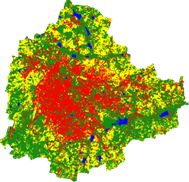
|
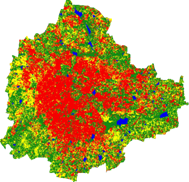
|
1973 |
1992 |
1999 |
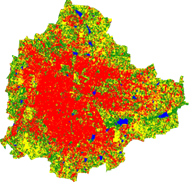
|
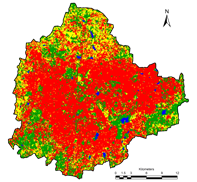
|
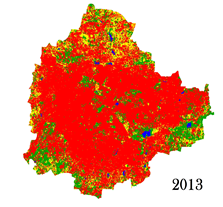
|
2006 |
2012 |
2013 |
© EWRG, CES, IISc |
Figure 3: Land use dynamics

|
Figure 4: Lakes of Bangalore |
Table 4: Temporal Land use dynamics
Class |
Urban |
Vegetation |
Water |
Others |
Year |
Ha |
% |
Ha |
% |
Ha |
% |
Ha |
% |
1973 |
5448 |
7.97 |
46639 |
68.27 |
2324 |
3.4 |
13903 |
20.35 |
1992 |
18650 |
27.3 |
31579 |
46.22 |
1790 |
2.6 |
16303 |
23.86 |
1999 |
24163 |
35.37 |
31272 |
45.77 |
1542 |
2.26 |
11346 |
16.61 |
2006 |
29535 |
43.23 |
19696 |
28.83 |
1073 |
1.57 |
18017 |
26.37 |
2012 |
41570 |
58.33 |
16569 |
23.25 |
665 |
0.93 |
12468 |
17.49 |
2013 |
50440 |
73.72 |
10050 |
14.69 |
445.95 |
0.65 |
7485 |
10.94 |
Image Fusion: Fusion of multispectral data (Resourcesat 2) and Cartosat (2.7 m) data was done using algorithms – Hyper-spectral Color Space resolution (HCS) merge, High Pass Filter (HPF) fusion, Modified Intensity Hue Saturation (MHIS) fusion, Wavelet Fusion. Quality and accuracy of fused data was assessed using UIQI value. All fusion techniques (except wavelet) were heavy intensive process which consumed 12 cores and 36 hrs of times on cloud computing networked systems. Among these, HCS provided better results, which aided in digitization of tree canopies in Bengaluru.
The land use analysis was carried out using HCS fused remote sensing data using the supervised classifier based on Gaussian Maximum Likelihood Classifier (MLC). Categories include two classes - vegetation and non-vegetation (built-up, water bodies, open area, etc.). Figure 5 illustrates the spatial distribution of vegetation (tree canopy). Accuracy assessment show the overall accuracy of 91.5% the kappa of 0.86 indicating higher agreement of the classified data and field data. Results highlight that spatial extent of tree vegetation is about 100.02 sq.km. (14.08%).
Tree distribution in wards: Vector layer of wards (administrative boundaries in Bangalore city) is overlaid on Figure 5, to extract the vegetation information for each ward. Figure 6 shows the ward wise distribution of vegetation and ward-wise tree statistics. Spatial extent of vegetation is minimum (less than 1 hectare) in wards such as Chickpete, Shivajinagara, Kempapura Agrahara, Padarayanapura, while wards such as Varthur, Bellandur, Agaram have higher vegetation cover (> 300 hectares).
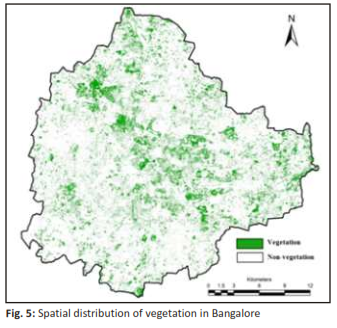 
Bangalore was divided into 1 km incrementing radii circles (with respect to the central business district) to assess the vegetation gradient. Figure 7 depicts vegetation density in each concentric regions in 1973 and 2013. Figure 7 illustrates the decline of vegetation during the last 4 decades. Presence of Lalbagh, Cubbon park, Indian Institute of Science campus, etc. in the core area show better vegetation density in the respective gradients. Figure 8 illustrates ward wise vegetation density for 2013. The wards such as Hudi, Aramane nagara and Vasantha pura have higher vegetation density of more than 0.4, while Chickpete, Laggere, Hegganahalli, Hongasandra, Padarayanapura have lower density with less than 0.015. Average vegetation density in Bangalore is about 0.14 (i.e., vegetation density: 0.14; Area of Bruhat Bangalore: 741 sq.km, Area under vegetation: 100.20 sq.km)
Figure 7: Gradient wise Vegetation density
Figure 8: Ward wise vegetation density (2013)
Field data was collected using GPS in select wards (covering 10% City’s spatial extent), which include tree census with the canopy dimensions. Canopy was also delineated using online Google Earth (http://Earth.google.com). This helped in quantifying number of trees based on delineation of canopy from remote sensing data. Figure 9 gives the frequency distribution based on the canopy size for wards i) < 500 trees and ii) > 500 trees. Based on these, number of trees in each ward are computed. Wards such as Vathuru, Bellanduru, Agaram, Aramane Nagara have the trees greater than 40000 trees, while Chickpete, Padarayanapura, Shivaji Nagara, Kempapura Agrahara, Kushal Nagara wards have trees less than 100 trees. Based on these, total number of trees in Bangalore is about 14,78,412 trees. Annexure I provides details of prominent trees in Bangalore.
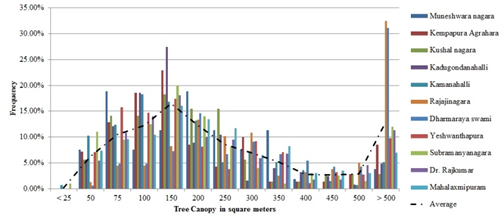
|
Wards < 500 trees |
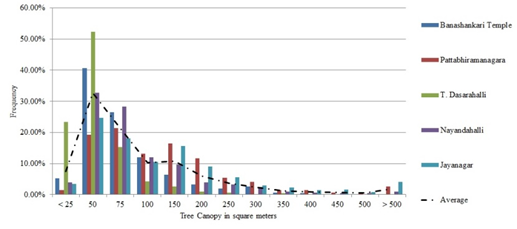
|
Wards >500 trees |
Figure 9: Histogram of trees based on canopy size
Validation of tree quantification was done in select wards of Bangalore. Figure 10a gives the tree distribution based on field census in Indian Institute of Science (IISc) Campus (Spatial extent 178 hectares) and Figure 10b gives the canopy distribution based on pattern classifier. Total number of trees as per the census is 22,201 and figure 11 gives the frequency distribution of canopy classes. Based on the remote sensing data, IISc campus with spatial extent of 178 hectares has canopy cover of 107.85 hectares and number of trees as 22,616. This means the accuracy of tree estimation based on canopy delineation using fused remote sensing data of 2.7 m spatial resolution is 97%.
Figure 12 depicts the ward wise population during 2013, computed considering the growth rate based on the population of 2001 and 2011. This shows wards in the core area of the city have population more than 40000 persons, whereas the wards towards the periphery have population less than 30000. Figure 13 depicts ward wise trees per person computed considering number of trees and population for the respective ward. This analysis shows that Shivaji Nagara, Dayananda Nagara, Chickpete, Padarayanapura, Kempapura Agrahara wards have very less number of trees per person (< 0.002). This highlights that these wards have less than 1 tree for every 500 people. Compared to this, wards such as Bellanduru, Jakkuru, Varthuru, Agaram, Aramane Nagara have trees more than one per person indicating the presence of one tree for every person.
|
![]]](f10b.png)
|
- Tree Census using GPS
|
- Trees from remote sensing data through pattern classifiers
|
Figure 10: Tree Distribution in Indian Institute of Science campus

Figure 11: Frequency Distribution based on field measurement
Comparative analyses of trees per person based on published literatures, reveal that Gandhinagar in Gujarat and Nashik in Maharashtra has more than 1 tree per person (Singh, 2013), while most of other cities are less than one tree per person. Major cities such as Gandhinagar, Bangalore, Ahmedabad, Brihan Mumbai are with spatial extent greater than 400 sq.km. Gandhinagar has 416 trees for every 100 people (4 tress per person) followed by Nasik (2 tress per person) Bangalore with 16 trees (one tree per 7 persons), Brihan Mumbai with 15 trees and Ahmedabad with 11 trees. Table 5 lists city wise number of trees and trees per person, which highlights of 4 trees per person in Gandhinagar, 2 trees per person in Nasik compared to one tree for 7 persons in Bangalore.

|

|
Figure 12: Ward wise population during 2013 |
Figure 13: Ward wise trees per person |
Table 5: Comparative assessment of trees across different cities
State
|
Location |
Population |
Area (Ha) |
Number of Trees |
Trees / person |
Trees / Hectare |
Reference |
Gujarat |
Ahmedabad |
5570590 |
46985 |
617090 |
0.111 |
13.13 |
21 |
Surat |
4462000 |
39549 |
333970 |
0.075 |
8.44 |
21 |
Vadodara |
1666700 |
16264 |
747190 |
0.448 |
45.94 |
21 |
Gandhinagar |
208300 |
57000 |
866670 |
4.161 |
15.20 |
21 |
Rajkot |
1287000 |
10400 |
139520 |
0.108 |
13.42 |
21 |
Bhavnagar |
593770 |
5320 |
485950 |
0.818 |
91.34 |
21 |
Junagafh |
320250 |
5670 |
76690 |
0.239 |
13.53 |
21 |
Jamnagar |
529310 |
3434 |
45880 |
0.087 |
13.36 |
21 |
Maharashtra |
Nagpur |
2405421 |
21717 |
2143838 |
0.891 |
98.72 |
22 |
Nashik |
1486973 |
25900 |
2055523 |
1.382 |
79.36 |
22 |
Brihan Mumbai |
12478447 |
43771 |
1917844 |
0.154 |
43.82 |
22 |
Kalyan* |
472208 |
5198 |
212795 |
0.451 |
40.94 |
22 |
Thane |
1818872 |
12700 |
45262 |
0.025 |
3.56 |
22 |
Navi Mumbai |
1119477 |
16205 |
478120 |
0.427 |
29.50 |
22 |
Nanded |
550564 |
4906 |
101310 |
0.184 |
20.65 |
22 |
Mira and Bhayandar |
814655 |
7904 |
150000 |
0.184 |
18.98 |
22 |
Karnataka |
Bangalore |
9582199 |
74100 |
1478412 |
0.155 |
19.95 |
calculated |
* Kalyan and Dombivali, combined together has population of 1,246,381 and area of 137.15 sq.km, proportion of area was used to calculate population of Kalyan city
|


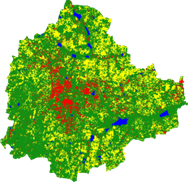








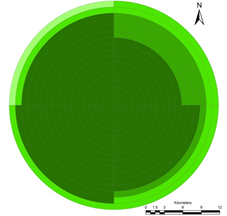
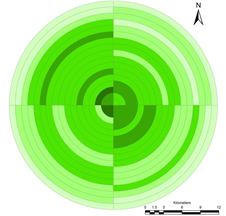



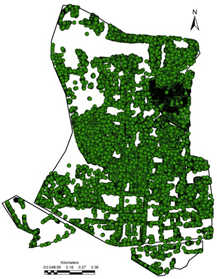
![]]](f10b.png)


